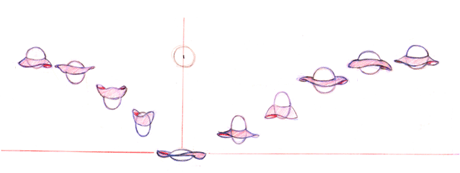My favorite lesson is one of the hardest for newbies to understand - and it is one of the most fun.
Since I began my stint as an instructor at Fullsail University, I have been rethinking how I teach animation. A little self analysis is a good thing from time to time. I can remember talking with Chuck Jones and he was ALWAYS rethinking his approach toward his animated projects.
My favorite lesson is one of the hardest for newbies to understand - and it is one of the most fun. When I first saw this information in book #26 Cartoon Animation by animation great, Preston Blair, I was stunned at the complexity of the information. Only after much scrutiny and gnashing of teeth was I able to decipher Preston's information.
Once you know something, it is no longer "scary" - now it is a normal part of my animation life.
Here are some highlights from the lesson on my website. There are about a dozen free lessons in the ANIMATION section of my website.
"Overlapping Action is another of the cornerstones of animation. By overlapping the actions of a characters' body, hair, tail, clothing, etc. your animation will feel more fluid and life-like.
In life, everything moves at different speeds and at different times. OVERLAPPING ACTION is a tool used by animators to emphasize the action and mood of the character. When a character moves across the screen some parts of the body move before or at different rates than others. Some parts of the body will LEAD the action and some parts will FOLLOW the main action.
Here is a “jump” action. The main action begins with the legs. They are the motivational force of the action. In other words, the legs make the action of the character stop and start. The legs motivate the action."



TO RECAP
- OVERLAPPING ACTIONS make for your animation more fluid. Use the body, hair, tail, clothing, etc. to follow the lead actions and movements
- Know the motivational force of the action ( which part of the body or force makes it move).
- Use “S” curves during movement transitions (when changing directions).
- Look for the main actions to drag other elements - like body parts, hair. clothes, tails, etc.
HINTS
- OVERLAPPING ACTIONS occur when elements begin, arrive or stop at different times.
- ALL ACTIONS move with with their own ARCS. That includes: body parts, hair, tails, clothes, etc.
- When animating a scene begin with the main part of the action there add the secondary and overlapping actions
Remember, keep it fun!
Always Animated








